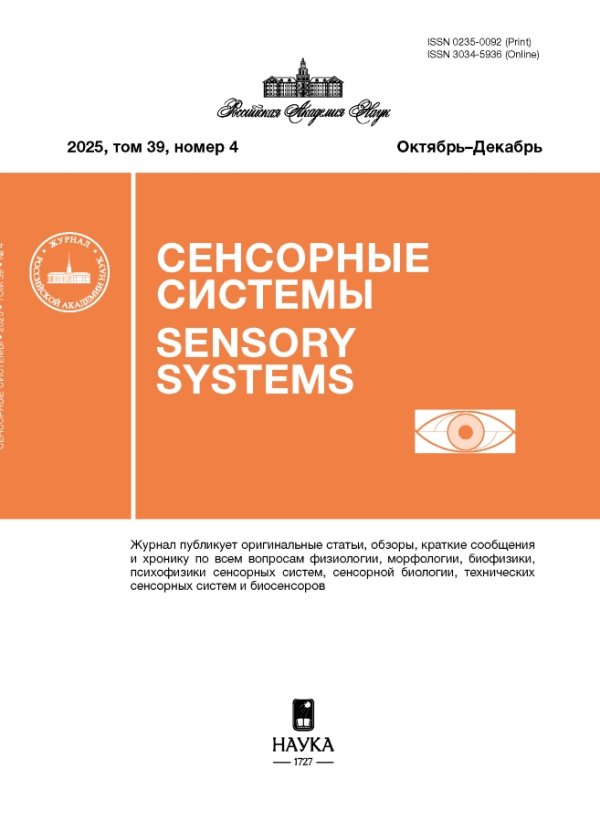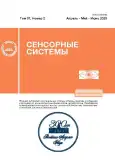Analysis of the gaze fixations in performance of mental recall of the route on a city map. Effects of landmark type and gender
- Authors: Kushnir A.B.1, Mikhailova E.S.1, Gerasimenko N.Y.1, Kazarezova I.A.1
-
Affiliations:
- Institute of Higher Nervous Activity and Neurophysiology of RAS
- Issue: Vol 37, No 2 (2023)
- Pages: 138-151
- Section: ЗРИТЕЛЬНАЯ СИСТЕМА
- URL: https://journals.rcsi.science/0235-0092/article/view/138221
- DOI: https://doi.org/10.31857/S0235009223020026
- EDN: https://elibrary.ru/QSWNUU
- ID: 138221
Cite item
Full Text
Abstract
A psychophysiological eye-tracking experiment was conducted to investigate map navigation (including tasks of familiarization with the map, route memorization and recall of the route) as a function of landmark type (no landmarks, object landmarks, verbal landmarks, both types of landmarks) and gender. It was found that the number of fixations decreased and the fixation duration increased during recall compared to map familiarization and route memorization. The effect of task type on eye movements varied between route proximity areas. In the proximal areas, the number of fixations decreased during recall in comparison to memorization, while in the distal (“off route”) area the effect was opposite. These changes were pronounced in the male participants and did not reach statistical significance in the females. Men switched more frequently from the proximal to the distal area during memorization, thus forming a connection between the route and the remote environment. In contrast, women’s gaze was more often directed to the distal area during route recall. The map with object landmarks differed from the other maps in the lower number and longer fixation duration, indicating the advantage of object landmarks and, possibly, a preference for the object visual cognitive style among our participants.
Keywords
About the authors
A. B. Kushnir
Institute of Higher Nervous Activity and Neurophysiology of RAS
Author for correspondence.
Email: naya.kushnir@gmail.com
Russia,
117485, Moscow, Butlerova str., 5A
E. S. Mikhailova
Institute of Higher Nervous Activity and Neurophysiology of RAS
Email: naya.kushnir@gmail.com
Russia,
117485, Moscow, Butlerova str., 5A
N. Yu. Gerasimenko
Institute of Higher Nervous Activity and Neurophysiology of RAS
Email: naya.kushnir@gmail.com
Russia,
117485, Moscow, Butlerova str., 5A
I. A. Kazarezova
Institute of Higher Nervous Activity and Neurophysiology of RAS
Email: naya.kushnir@gmail.com
Russia,
117485, Moscow, Butlerova str., 5A
References
- Kushnir A.B., Gerasimenko N.Yu., Mikhailova E.S. Polovye razlichiya vypolneniya zadachi myslennogo vosproizvedeniya marshruta na karte gorodskoi mestnosti. Analiz dvizhenii glaz [Gender differences in perfomance of mental recall of the route on a city map. Analysis of the eye movements character]. Sensornye sistemy [Sensory systems]. 2019. V. 33 (4). P. 333–344 (in Russian). https://doi.org/10.1134/S0235009219040048
- Blajenkova O., Kozhevnikov M., Motes M.A. Object–spatial imagery: A new self–report imagery questionnaire. Appl. Cogn. Psychol. 2006. V. 20. P. 239–263. https://doi.org/10.1002/acp.1182
- Blazhenkova O., Kozhevnikov M. The new object–spatial–verbal cognitive style model: Theory and measurement. Appl. Cogn. Psychol. 2009. V. 23 (5). P. 638–663. https://doi.org/10.1002/acp.1473
- Bocchi A., Palermo L., Boccia M., Palmiero M., D’Amico S., Piccardi L. Object recognition and location: Which component of object location memory for landmarks is affected by gender? Evidence from four to ten year–old children. Appl. Neuropsychol. Child. 2018. V. 9. https://doi.org/10.1080/21622965.2018.1504218
- Boccia M., Vecchione F., Piccardi L., Guariglia C. Effect of сognitive style on learning and retrieval of navigational environments. Front. Pharmacol. 2017. V. 8. P. 496. https://doi.org/10.3389/fphar.2017.00496
- Brouwer A.M., Hogervorst M.A., Oudejans B., Ries A.J., Touryan J. EEG and eye tracking signatures of target encoding during structured visual search. Front. Hum. Neurosci. 2017. V. 11. P. 264. https://doi.org/10.3389/fnhum.2017.00264
- Brügger A., Richter K.F., Fabrikant S.I. How does navigation system behavior influence human behavior? Cogn. Res. Princ. Implic. 2019. V. 4 (1). P. 5. https://doi.org/10.1186/s41235-019-0156-5
- Cheng C.Y., Yen M.Y., Lin H.Y., Hsia W.W., Hsu W.M. Association of ocular dominance and anisometropic myopia. Invest. Ophthalmol. Vis. Sci. 2004. V. 45 (8). P. 2856–2860. https://doi.org/10.1167/iovs.03-0878
- Gagnon K.T., Thomas B.J., Munion A., Creem-Regehr S.H., Cashdan E.A., Stefanucci J.K. Not all those who wander are lost: Spatial exploration patterns and their relationship to gender and spatial memory. Cognition. 2018. V. 180. P. 108–117. https://doi.org/10.1016/j.cognition.2018.06.020
- Grön G., Wunderlich A.P., Spitzer M., Tomczak R., Riepe M.W. Brain activation during human navigation: gender–different neural networks as substrate of performance. Nat. Neurosci. 2000. V. 3 (4). P. 404–408. https://doi.org/10.1038/73980
- Harris T., Scheuringer A., Pletzer B. Perspective and strategy interactively modulate sex differences in a 3D navigation task. Biol. Sex Differ. 2019. V. 10 (1). P. 17. https://doi.org/10.1186/s13293-019-0232-z
- Höffler T.N., Koć-Januchta M., Leutner D. More evidence for three types of cognitive style: Validating the Object–Spatial Imagery and Verbal Questionnaire using eye tracking when learning with texts and pictures. Appl. Cogn. Psychol. 2017. V. 31. P. 109–115. https://doi.org/10.1002/acp.3300
- Irving S., Schöberl F., Pradhan C., Brendel M., Bartenstein P., Dieterich M., Brandt T., Zwergal A. A novel real–space navigation paradigm reveals age- and gender–dependent changes of navigational strategies and hippocampal activation. J. Neurol. 2018. V. 265 (1). P. 113–126. https://doi.org/10.1007/s00415-018-8987-4
- Klippel A., Hirtle S., Davies C. You–Are–Here Maps: Creating spatial awareness through maplike representations. Spat. Cogn. Comput. 2010. V. 10. P. 83–93. https://doi.org/10.1080/13875861003770625
- Klippel A., Richter K.F., Barkowsky T., Freksa C. The cognitive reality of schematic maps. Map–based mobile services. Eds. Meng L., Reichenbacher T., Zipf A. Berlin, Heidelberg. Springer, 2005. P. 55–71. https://doi.org/10.1007/3-540-26982-7_5
- Kong X.Z., Huang Y., Hao X., Hu S., Liu J. Sex–linked association between cortical scene selectivity and navigational ability. Neuroimage. 2017. V. 158. P. 397–405. https://doi.org/10.1016/j.neuroimage.2017.07.031
- Kozhevnikov M. Cognitive styles in the context of modern psychology: toward an integrated framework of cognitive style. Psychol. Bull. 2007. V. 133 (3). P. 464–481. https://doi.org/10.1037/0033-2909.133.3.464
- Kraemer D.J.M., Schinazi V.R., Cawkwell P.B., Tekriwal A., Epstein R.A., Thompson–Schill S.L. Verbalizing, visualizing, and navigating: The effect of strategies on encoding a large–scale virtual environment. J. Exp. Psychol. Learn. Mem. Cogn. 2017. V. 43 (4). P. 611–621. https://doi.org/10.1037/xlm0000314
- Meister M.L.R., Buffalo E.A. Getting directions from the hippocampus: The neural connection between looking and memory. Neurobiol. Learn. Mem. 2016. V. 134. P. 135–144. https://doi.org/10.1016/j.nlm.2015.12.004
- Merrill E.C., Yang Y., Roskos B., Steele S. Sex differences in using spatial and verbal abilities influence route learning performance in a virtual environment: A comparison of 6– to 12–year old boys and girls. Front. Psychol. 2016. V. 7. P. 258. https://doi.org/10.3389/fpsyg.2016.00258
- Mitolo M., Gardini S., Caffarra P., Ronconi L., Venneri A., Pazzaglia F. Relationship between spatial ability, visuospatial working memory and self–assessed spatial orientation ability: a study in older adults. Cogn. Process. 2015. V. 16 (2). P. 165–176. https://doi.org/10.1007/s10339-015-0647-3
- Mueller S.C., Jackson C.P.T., Skelton R.W. Sex differences in a virtual water maze: An eye tracking and pupillometry study. Behav. Brain Res. 2008. V. 193(2). P. 209–215. https://doi.org/10.1016/j.bbr.2008.05.017
- Nazareth A., Huang X., Voyer D., Newcombe N. A meta–analysis of sex differences in human navigation skills. Psychon. Bull. Rev. 2019. V. 26 (5). P. 1503–1528. https://doi.org/10.3758/s13423-019-01633-6
- Nori R., Giusberti F. Predicting cognitive styles from spatial abilities. Am. J. Psychol. 2006. V. 119. P. 67–86. https://doi.org/10.2307/20445319
- Nori R., Piccardi L., Maialetti A., Goro M., Rossetti A., Argento O., Guariglia C. No gender differences in egocentric and allocentric environmental transformation after compensating for male advantage by manipulating familiarity. Front. Neurosci. 2018. V. 12. P. 204. https://doi.org/10.3389/fnins.2018.00204
- Pazzaglia F., De Beni R. Strategies of processing spatial information in survey and landmark–centred individuals. Eur. J. Cogn. Psychol. 2001. V. 13. P. 493–508. https://doi.org/10.1080/09541440042000124
- Pazzaglia F., Meneghetti C., Ronconi L. Tracing a route and finding a shortcut: The working memory, motivational, and personality factors involved. Front. Hum. Neurosci. 2018. V. 12. P. 225. https://doi.org/10.3389/fnhum.2018.00225
- Pazzaglia F., Moè A. Cognitive styles and mental rotation ability in map learning. Cogn. Process. 2013. V. 14 (4). P. 391–399. https://doi.org/10.1007/s10339-013-0572-2
- Piccardi L., De Luca M., Nori R., Palermo L., Iachini F., Guariglia C. Navigational style influences eye movement pattern during exploration and learning of an environmental map. Front. Behav. Neurosci. 2016. V. 10. P. 140. https://doi.org/10.3389/fnbeh.2016.00140
- Piccardi L., Palermo L., Bocchi A., Guariglia C., D’Amico S. Does spatial locative comprehension predict landmark–based navigation? PLoS One. 2015. V. 10(1). P. e0115432. https://doi.org/10.1371/journal.pone.0115432
- Saucier D.M., Green S.M., Leason J., MacFadden A., Bell S., Elias L.J. Are sex differences in navigation caused by sexually dimorphic strategies or by differences in the ability to use the strategies? Behav. Neurosci. 2002. V. 116 (3). P. 403–410. https://doi.org/10.1037//0735-7044.116.3.403
- Voyer D., Voyer S.D., Saint–Aubin J. Sex differences in visual–spatial working memory: A meta–analysis. Psychon. Bull. Rev. 2017. V. 24 (2). P. 307–334. https://doi.org/10.3758/s13423-016-1085-7
- Wolbers T., Wiener J.M. Challenges for identifying the neural mechanisms that support spatial navigation: the impact of spatial scale. Front. Hum. Neurosci. 2014. V. 8. P. 571. https://doi.org/10.3389/fnhum.2014.00571
- Yagi S., Galea L.A.M. Sex differences in hippocampal cognition and neurogenesis. Neuropsychopharmacology. 2019. V. 44 (1). P. 200–213. https://doi.org/10.1038/s41386-018-0208-4
Supplementary files














